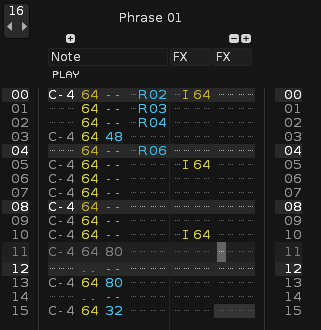@laamaa that helps a LOT. Thanks!
Looking through the .xrns and comparing this (super-compact, 4 LPB) phrase to the M8 table, I notice additional delays on lines 03,11,13, and 15:

I’m assuming these are necessary because you’d mentioned the retrigger commands work differently in M8 and Renoise. My guess is that Rxx stops with its step, but RET retriggers until done or stopped. I’ll try to confirm that with Teensy 4.1 + M8 Headless later.
I’m curious how you’d calculate those delays, but @slujr’s suggestion (New tool (3.1): Place selected notes evenly) looks like it could help there.
(Speaking of M8 headless, @laamaa: thank you for creating m8c! I didn’t realize you were the developer until @dspasic pointed out your GitHub)
+100 ― I’m new to Renoise, and this discussion has probably jump-started my understanding of how to use it effectively by six months.